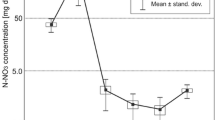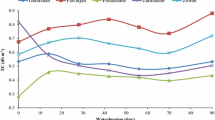Summary
A short term nitrification assay (<18 h) was used to assess the effect of high concentrations of different solutes on the rate of nitrate production. High solute concentrations were found to inhibit nitrification and the degree of inhibition was related both to the osmotic pressure of the soil solution and the osmoticum used. Ammonium chloride, ammonium sulphate and sorbitol were used as sources of osmotic pressure. The results showed that, with ammonium salts, no inhibition was observed with pressures less than 2 atm. Above these values, the severity of the inhibition followed the order ammonium chloride>ammonium sulphate>sorbitol up to the maximum osmotic pressure studied (25 atm). With ammonium chloride, a pressure of 3.5 atm. was sufficient to cause a 90% inhibition of nitrification rate.
The inhibition produced by mixtures of ammonium chloride and sorbitol, each mixture generating an osmotic pressure of 5 atm. in the assay, was also investigated. The results suggest that inhibition by Cl-ion is disproportionate to its contribution to the osmotic pressure of the soil solution.
The recovery of the nitrification rate, following exposure to high osmotic pressure solutions, was also investigated. It was found that the recovery of the nitrification rate was only partial, with the extent of the recovery diminishing as the severity of the initial osmotic stress applied increased. These results suggest that both reversible and irreversible mechanisms are involved in the inhibition of nitrification.
Similar content being viewed by others
References
Brewster J L, Bhat K K S and Nye P H 1975 The possibility of predicting solute uptake and plant growth response from independently measured soil and plant characteristics. III The growth and uptake of onions in a soil fertilised to different initial levels of phosphate and a comparison of the results with model predictions. Plant and Soil 42, 197–226.
Bundy L G and Bremner J M 1973 Inhibition of nitrification in soils. Soil Sci. Soc. Am. Proc. 37, 396–398.
Darrah P R, Nye P H and White R E 1985 Modelling growth responses of soil nitrifiers to additions of ammonium sulphate and ammonium chloride. Plant and Soil 86, 425–439.
Darrah P R, White R E and Nye P H Simultaneous nitrification and diffusion and diffusion in soil. II The effects at levels of ammonium chloride which inhibit nitrification. J. Soil Sci. (In press).
Darrah P R, Nye p H and White R E 1986 Simultaneous nitrification and diffusion in soil V The effect of pH change, following the addition of ammonium sulphate, on the growth and activity of nitrifiers. J. Soil Sci. (In press).
Hahn E B, Olson F R, and Roberts J L 1942 Influence of potassium chloride on nitrification in Bedford silt loam. Soil Sci. 55, 113–121.
Harris R F 1981 Effect of water potential on microbial growth and activity.In Water Potential Relations in Soil Microbiology. pp 23–96. Soil Sci. Soc. Am. sp. pub. No. 9.
McClung G and Frankenberger W T 1985 Soil nitrogen transformations as affected by salinity. Soil Sci 139 5, 404–411.
McCormick R W and Wolff D C 1980 Effect of sodium chloride on CO2 evolution, ammonification and nitrification in a sassafras sandy loam. Soil Biol. Biochem. 12, 153–157.
Pang P C, Hedlin R A and Cho C M 1973 Transformation and movement of band applied urea, ammonium sulphate, and ammonium hydroxide during incubation in several Manitoba soils. Can. J. Soil Sci. 53, 331–341.
Schmidt E L and Belser L W 1982 Nitrifying bacteria.In Methods of Soil Analysis Pt. 2 Chemical and Microbiological properties. Eds. Page A Let al. pp 1027–1041. Am. Soc. Agron. No. 9.
Sindhu M A and Cornfield A H 1967 Comparative effects of varying levels of chlorides and sulphates of sodium, potassium, calcium, and magnesium on ammonification and nitrification during incubation of soil. Plant and Soil 27, 468–472.
Skjemstad J O and Reeve R 1978 The automatic determination of ppb levels of ammonia, nitrate plus nitrite and phosphate in water in the pressence of added mercury (II) chloride. J. Environ. Qual. 7, 137–141.
Wickramasinghe K N, Rodgers G A and Jenkinson D S 1985 Nitrification in acid tea soils and a neutral grassland soil: effects of nitrification inhibitors and inorganic salts. Soil Biol. Biochem. 17, 249–252.
Author information
Authors and Affiliations
Rights and permissions
About this article
Cite this article
Darrah, P.R., Nye, P.H. & White, R.E. The effect of high solute concentrations on nitrification rates in soil. Plant Soil 97, 37–45 (1987). https://doi.org/10.1007/BF02149821
Received:
Revised:
Issue Date:
DOI: https://doi.org/10.1007/BF02149821




